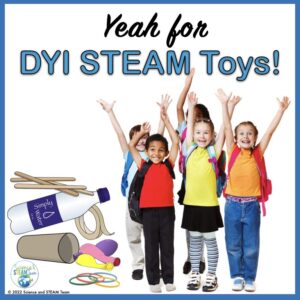Why STEAM Toys?
Research is showing that kids need STEAM Toys.
STEM is becoming increasingly relevant as the world delves deeper into this techno-centric era. And the Bureau of Labor Statistics projects an 8% increase in STEM occupations by 2029, over other careers at only 3.7%. Moreover, an astounding 93% of parents agreed that STEM should be a priority in the country, according to Microsoft’s survey on parents’ STEM perceptions.
That said, the relevance of STEM can never be understated. Apart from manuals, children can learn STEM best by playing with toys that promote STEM learning (a.k.a. STEM toys). And what better way to ignite a child’s sense of wonder in the field than in school.
However, not every child is privileged to have STEM toys, which might thwart future scientists from fully pursuing their calling. So we compiled three simple DIY STEAM toys that students (or children at home, alike!) can make themselves.
Check them below!
3 Simple DIY STEAM Toys for Kids
STEAM Toys: DIY Popsicle Toy Car
Every child, at one point, has experienced playing with toy cars. Whether that’s an analog toy car or remote-controlled, seeing the toy drift and spin and crash fills kids with ecstasy.
In this activity, students create their own toy car using recyclable materials. This craft will not only be fun and engaging but will also be a small step towards saving the environment!
Kids will learn the value of recycling as they make this DIY STEM toy. And, they’ll apply physics principles like torque to get the car running.
Materials:
- 2 popsicle sticks
- 1 rubber band
- 4 plastic bottle caps (exact sizes)
- Plastic straw
- 1 Weight-adding material (can be an A.A. battery, bolt, or small stone)
- Glue gun
Directions:
You may refer to the video above from Yuri Ostr for a live demonstration of how to create a simple DIY craft.
- Create a V-shape by joining both ends of 2 popsicle sticks using a glue stick. We’ll call this the V-shaped car.
- Cut the plastic straw into three 1-inch long portions.
- Glue a 1-inch piece of the straw to the jointed portion of the V-shaped car. Again, glue each of the remaining 1-inch straw pieces to each separate end of the V-shaped car. These straws are where the skewers will be inserted.
- Insert the skewers into the straw. This will be the hub where the wheels (bottle caps) are attached. Feel free to cut the skewers accordingly, as long as there will be ample space for the caps to move.
- Make a hole in all bottle caps, enough to fit the skewers in. Insert all bottle caps on all skewers to make the wheels.
- Glue a one-inch-long skewer in the center of the rear hub. Glue another one-inch skewer to the jointed end of the V-shaped car. Hang a rubber band to both one-inch-long sticks; this will act like a pullback motor.
- Add the weight-adding material to one (or both) separate ends of the V-shaped car. This will keep the vehicle balanced while running.
- Play with the DIY STEM toy car like a regular pullback motor car!
STEAM Toys: DIY Plastic Bottle Toy Car
The design of this DIY STEAM toy shares some similarities with the previous one, except, in this version, we’ll use plastic bottles as the main materials over popsicle sticks. Nevertheless, the tools used here are still recyclable materials, so a similar eco-friendly impact is observed!
Materials:
- 2 Plastic bottles
- 4 Rubber bands
- 3 Skewers
- 4 extra plastic bottle caps (same sizes)
- Glue gun
- Cutter/scissors
Directions:
The steps to make this DIY STEAM toy is not complicated. Although seeing how Basu Creations did it in the video above is more straightforward than putting the directions into words.
We advise teachers or parents to assist kids in areas where cutting or gluing is involved to avoid potential injuries.
STEAM Toys: DIY Mini Ball Game
Do you remember those vintage ball-in-the-hole games we used to play as kids? Well, they’ve helped build a child’s dexterity and motor skills, not to mention the self-control we learned despite being frustrated in getting the balls to enter the holes.
That’s what we’re doing today!
This DIY STEAM toy is very different from the first two we’ve made. We’ll replicate those fun mini ball games using the principles of STEAM. Children’s creativity will shine through in making this craft.
Materials:
- Recycled plastic lids
- Cardboard
- Colored pens (any coloring material)
- Small beads
- Hole punch
- Scissors
- Glue
Directions:
Like the previous video, observing making the game is easier than explaining the steps in words. Thankfully, Babble Dabble Do has a live demonstration showing how to create the game. Check the video below:
Can’t Buy Them? Make Them!
From kids’ microscopes to complicated science kits, countless STEM toys flood the market nowadays. However, not every child has access to these STEM-promoting toys, increasing their interest in the field, as children learn best during play.
The activities above cater to all children and students, whether privileged or not. It gives them equal access to STEAM toys and the ability to experience the joy of playing while learning. There are tons of STEAM principles kids can learn through hands-on activities, and these DIY STEAM toys are a glorious example.
Who knows? Maybe these simple crafts are the subtle nudge to unleash your students’ (or child’s) inner budding scientist.
Ready-made science gadgets may also do the trick.
Howdy hey! I’m Joel, a guest blogger for The Science and STEAM Team. I am also a digital content creator for TheSTEMKids, which aims to ignite STEM curiosity among youngsters through engaging and thought-inducing toys. P.S. our STEM toys make perfect gifts to children you love too! Feel free to drop by 😊
If you are looking for more DYI STEAM activities, read our post: Summer STEM Challenge: Are You Looking for a Fun One?
And remember, it’s all science!



